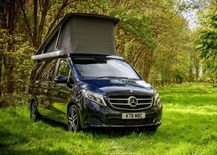Mercedes-Benz Marco Polo Review 2025
Mercedes-Benz Marco Polo At A Glance
The Mercedes-Benz Marco Polo is the premium alternative to the Volkswagen California and - like its German rival - provides a smart combination of upmarket family transport and five star accommodation.
Mercedes-Benz doesn't the enjoy the same camper van history as Volkswagen, but the Marco Polo more than makes up for lost time, with its interior and high levels of standard equipment providing a notable edge against the similarly priced Volkswagen California Ocean.
Converted by Westfalia - a German specialist that made its name by converting Volkswagen vans in the 1970s and 1980s - the Marco Polo provides a home from home experience, with kitchenette that features twin gas hob, running water and a fridge. The rear bench adjusts electrically into a flat and comfortable double bed, and two more can sleep in the raised roof, which is also electrically operated.
Like the California, the Marco Polo gets external connections for power and fresh water, with the latter providing a supply for the compact sink and taps located next to the gas hob. The leather interior also gets swivelling driver and passenger seats, a foldable table and three-zone climate control. A removable camping table plus two chairs, with storage bag, are located in the boot.
Everything is easy to use and find, with LED ambient lighting and soft closing cupboards and drawers giving the Marco Polo's living space a smart and modern feel. Both the side sliding door and tailgate are electric, while the options list includes an auxiliary heater that will provide warm air when you're parked up for the night. The split tailgate is also a useful feature, allowing you to access the boot in a car park when space is limited.
Under the bonnet of the Marco Polo is a 2.1-litre turbodiesel engine. The four-cylinder diesel is the same unit found in the V-Class and is available in two outputs – 163PS and 190PS - and both will officially return 44.8mpg. A seven-speed automatic transmission is standard across the range.
Given its premium feel, beautifully crafted interior and high levels of standard equipment, the Mercedes-Benz Marco Polo edges ahead of the Volkswagen California on almost every level. On the downside, there is no four-wheel drive option and some of the optional extras are a little disappointing in quality - the awning is particularly poor - but small niggles aside the Marco Polo is the best compact camper van money can buy.
Driven: Mercedes-Benz V-Class Marco PoloUpmarket and packed with luxurious kit - which includes yacht-style wooden flooring - the Marco Polo feels every inch a Mercedes-Benz. The fit and finish of the interior is exquisite, and the car-like refinement makes a real difference. |
|
Driving the Mercedes-Benz Marco Polo
Like the standard V-Class, the Marco Polo is a comfortable and refined long distance cruiser. The dashboard is carried over from the van-based MPV, with a smart layout and tablet-style screen sitting in the middle, while general visibility is good, thanks to the large windscreen and wide door mirrors.
The Marco Polo is offered with just one engine - a turbocharged 2.1-litre diesel - in two outputs levels: 163PS or 190PS. The entry-level 220d is more than up to the task of powering the 2.4 tonne Marco Polo along, with the four-cylinder diesel producing 380Nm of torque. Most of the acceleration is available from low down the rev range, which means the Marco Polo always has a useful glug of acceleration for pulling away from a junction or overtaking slow moving traffic.
As you might expect, the more powerful 250d is the more accomplished of the two powertrains, with 440Nm of torque available from 1400rpm. This means it is better for towing - the van will shift two tonnes when hooked to a braked trailer or caravan - although the front-wheels have a tendency to slip on wet grass or loose gravel. Unlike some of its rivals, Mercedes-Benz doesn't offer its camper with the option of four-wheel drive.
Both engines are refined and will return an advertised 44.8mpg. The ride is on the firm side of comfortable, but road and engine noise levels are well suppressed, which means the Marco Polo feels more like a large car than a crude van conversion. The 2.1-litre diesel engines are linked to a seven-speed G-Tronic Plus automatic gearbox. There are no manual options, but the automatic gearbox works well for the most part, with smooth changes and decent anticipation of the up and down shift on the motorway. That said, the 'box does have muddled moments on hilly A-roads, with a tendency to perform needless downshifts.
For the most part, however, the Marco Polo is quiet and pleasant to drive. It does a good job of hiding its considerable bulk, thanks to responsive steering and an automatic hill hold system that will prevent the van from rolling backwards when waiting at a junction or queuing in traffic on a steep hill. Parking is also easy, with the van's nimble steering and two metre height making it a stress free fit into most urban car parks.
Like the Mercedes-Benz car range, Command Online is available, with navigation and live traffic updates. The infotainment system is operated via a touchpad and rotary wheel, while a row of high quality switches - that wouldn't feel amiss in the S-Class – are situated below the screen to provide easy access to important controls. Cup holders are a rare commodity, however, with the plastic holders in the door bins prone to spilling drinks.
Safety equipment is well catered for with all vans getting a radar system that will warn the driver if they’re travelling too close to the vehicle in front. If the system thinks there is a risk of an accident, it will warn the driver and assist with braking to help prevent a rear end collision. The Marco Polo also gets parking sensors and a rear-view camera.
Mercedes-Benz Marco Polo interior
The Marco Polo will not disappoint those who've always yearned for a Mercedes-Benz they can genuinely live in. Capable of sleeping up to four adults, the Marco Polo provides five star comfort that will leave your campsite neighbours peering out of their tents with envy.
The interior layout is pretty much identical to the Volkswagen California Ocean but there are some notable differences that give the Marco Polo an edge, with plush leather seats, yacht-style wood flooring and electric tailgate and side door. The van also has electric hook-up and an internal water tank, which mean it really does feel like a home from home.
The living space can be set up in a matter of minutes, with the electronic pop-up roof and swivelling front seats taking just a few moments to organise. LED lights are scattered throughout the cabin and include coloured ambient lighting to give the interior a living room feel. Most of the windows are tinted, but if you want complete privacy then individual blinds will block out the world, while a cloth cover will obscure the windscreen and side windows.
The Marco Polo has two double beds. To get the first, you must electronically lower the second row of seats, while the second bed - provided in the pop-up roof - is the most spacious and comfortable. When not in use, the upper bed can be folded away. However, unlike the California, the upper bed isn't automatically held up by gas struts, which means you have to push it up with one hand and then clip it in place with the other, which is a little fiddly.
Operating the kitchen is easy, with the twin hob burner linked to a gas bottle that's situated in the boot. The fold out table, compact fridge and sink provide everything you need to store and prepare food. Running water is also supplied via a built-in water tank, which can easily be filled via an external filler cap. Waste water is collected in a separate tank that can then be emptied into a waste water tank.
Given its high price, standard equipment is understandably high, with tinted rear glass, leather upholstery, split tailgate and a camping table with two chairs. However, DAB audio is missing from the standard kit and the camping table and chairs sit in a compartment in the boot, which eats up large chunk of the Marco Polo's 670-litre capacity.
The options list is comprehensive, with navigation, electric seats and auxiliary air heater all available. You can also fit a water heater, although this unit will only pre-heat the engine coolant - it won't provide hot running water for the taps from the internal water tank. A roll-out side awning is also available, but feels somewhat like an aftermarket afterthought, owing to its poor quality and flimsy metal supports that have a tendency to rattle loudly as you drive along.
Model History
- August 2014: Mercedes-Benz unveils the Marco Polo
- December 2016: Mercedes-Benz confirms Marco Polo pricing
August 2014
Mercedes-Benz unveils the Marco Polo
The Marco Polo Activity is equipped as standard with a three-seater bench with one-piece backrest and bed extension. The bench can be slid forward on rails. In this way, the capacity of the luggage compartment can be more than doubled in an instant to accommodate surfboards, paragliding equipment or even a bicycle inside the vehicle.
Anyone who requires even more room can also use the surface of the bed and the floor underneath the bed as load space. Under the bed are two drawers that can be removed, allowing items to be loaded through the resulting space.
When spending the night in the vehicle, the bench seat easily converts into a comfortable bed measuring 1.93 metres by 1.35 metres for three people. An additional sleeping facility for two people is offered by the roof bed under the pop-up roof on board the new Marco Polo. Featuring a cold foam mattress and special spring elements with high point elasticity, this bed offers a standard of lying comfort that is exceptional in the segment.
When the luxury roof bed is not in use it can be folded upwards at the front when the roof is raised. This provides plenty of headroom in the vehicle interior. At the same time, the two side ventilation slits in the concertina direct even more fresh air into the interior. The two standard-fit vent windows in the rear provide for an added supply of pleasant fresh air.
They can be opened and closed electrically – a unique selling point for the Marco Polo Activity in the compact recreational vehicle segment. Curtains in the rear also come as standard. To allow the interior to be darkened completely, an opaque and washable curtain is available for the windscreen and the front side windows.
The Marco Polo Activity features a standard folding table with a scratch-resistant surface. In addition to an amply sized surface, the table also includes a bottle holder and two cup holders. More bottle holders, cup holders, stowage compartments as well as a total of five 12 volt power sockets are to be found on the sidewalls of the rear compartment, in the cockpit and in the luggage compartment. Ideal lighting is provided by a total of four reading lamps in the rear and two adjustable LED gooseneck lamps on the roof bed.
The Marco Polo Activity offers the option of an awning above the sliding door, which is also detachable – a first for this segment. This means there is no need to have it permanently attached and allows it to be removed before driving through an automatic car wash.
For the front-wheel drive, the new 1.6-litre four-cylinder unit with common-rail direct injection is available with 88PS or 114PS. The turbodiesel engine has economical fuel consumption of up to 44.1mpg. Even greater performance is provided by the 2.1-litre four-cylinder diesel engine with two-stage turbocharging in conjunction with rear-wheel drive.
This engine is available with an output of 136PS, 163PS or 190PS. With average NEDC consumption up to 48.7mpg and CO2 emissions of just 152 g/km, the 163PS Marco Polo Activity 220 CDI leads the way in its segment. The top-of-the-range Marco Polo Activity 250 BlueTEC has 190PS and 440Nm of torque on tap while achieving up to 47.0 mpg.
December 2016
Mercedes-Benz confirms Marco Polo pricing
The Mercedes-Benz V-Class Marco Polo is available from £53,180 for the entry-level V 220 d Sport. The V 220 d AMG Line is £55,320, the V 250 d Sport £55,055 and the V 250 d AMG Line is £57,195.
The Marco Polo is based on the V-Class, and can seat or sleep four people. It comes with a full range of equipment including a built-in kitchenette with a fridge and hob, plus a two-seater sofa which can easily be transformed into a bed (with under-bed storage). It also features a roof bed, accessed via an electrically raising roof; a wardrobe and a generous luggage compartment.
As standard, Sport models come with a two-seater sofa with bed extension; yacht wood flooring in rear compartment (available in a choice of two colours at no extra cost); camping table plus two chairs with storage bag; electrically operated pop-up roof; swivelling driver and passenger seats; automatic three- zone climate control; external connections for power and fresh water; tinted rear windows; 18-inch alloy wheels; ambient lighting; Garmin navigation system; leather upholstery; Active Parking Assist with rear-view camera; and split tail gate.
For an additional £2140, AMG Line models add AMG bodystyling; 19-inch AMG bi-colour wheels; sports suspension; carbon-look dash; AMG spoiler lip on tailgate; and metallic paint.
For £595, the Lane Tracking package includes Blind Spot Assist and Lane Keeping Assist. The Driving Assistance package is optionally available for £1,695 and includes Distronic Plus; Blind Spot Assist; Pre-Safe; and Lane Keeping Assist.
Stand alone options include metallic paint (£645); Comand Online infotainment system (£1795); 360° camera (£335); extra individual seat in the middle row (£1045); side awning (£695); and auxiliary heating (£1345 – available across the entire V-Class range).

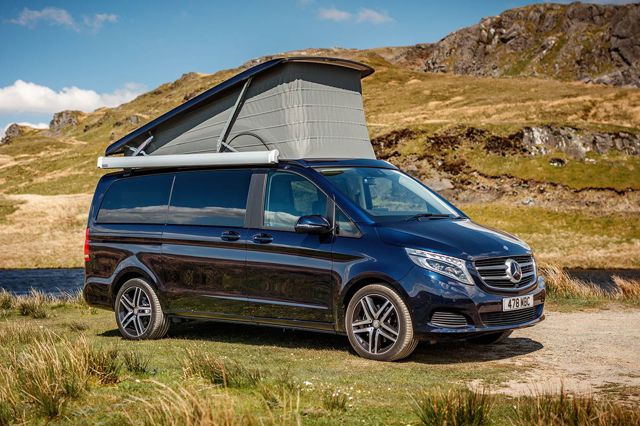
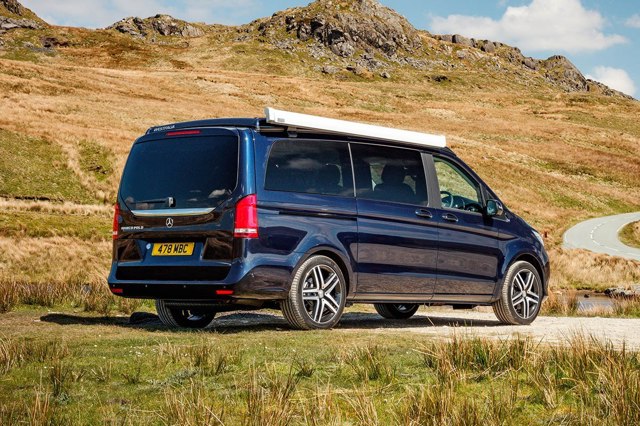

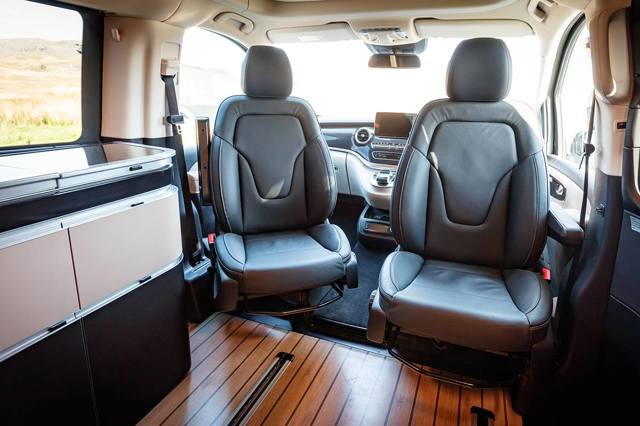

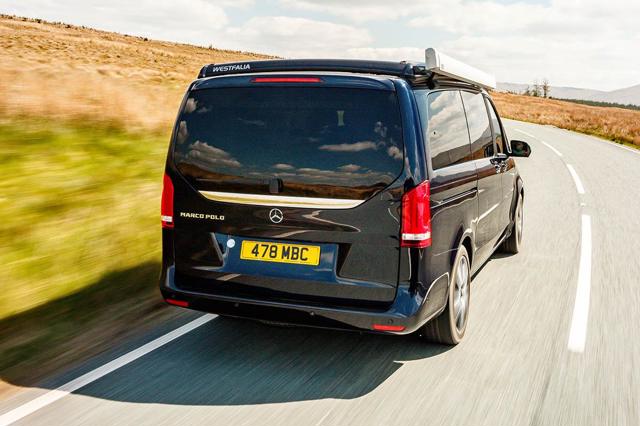
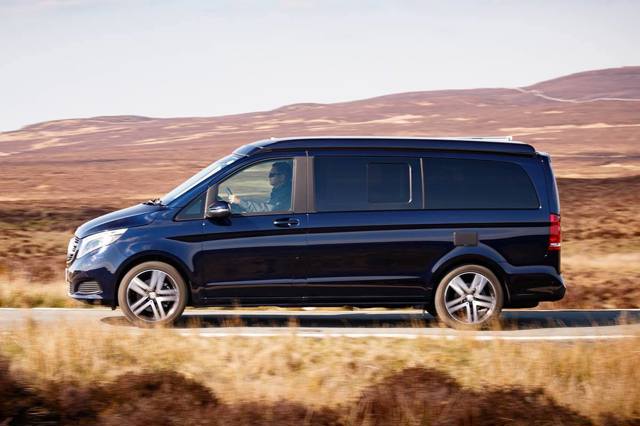
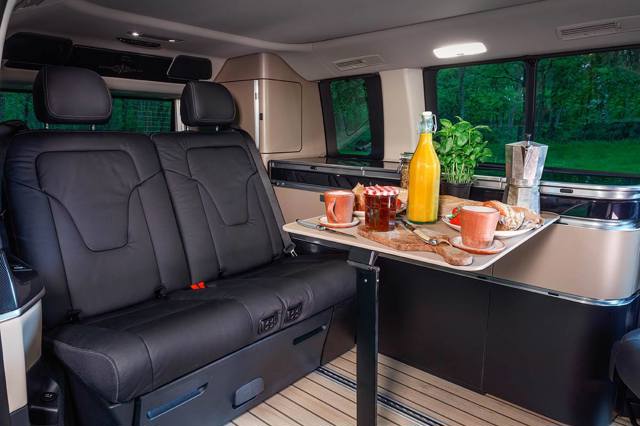
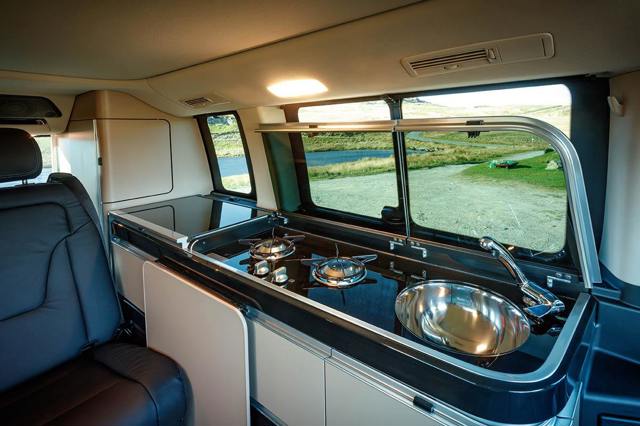
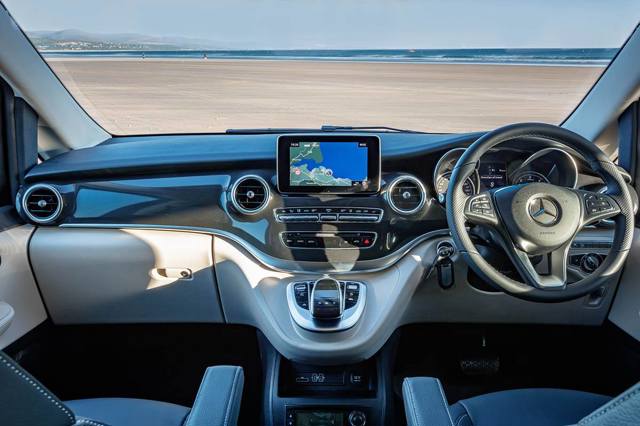

 Premium alternative to the standard camper, plush interior will sleep four, electric sliding door and tailgate fitted as standard.
Premium alternative to the standard camper, plush interior will sleep four, electric sliding door and tailgate fitted as standard.
 High starting price, automatic only, quality of optional side awning could be better.
High starting price, automatic only, quality of optional side awning could be better.
